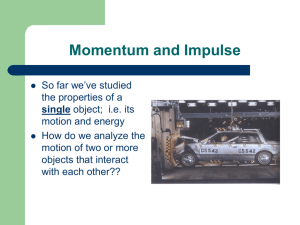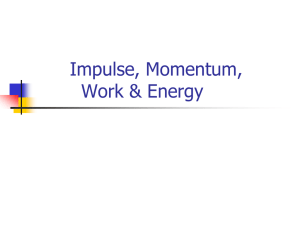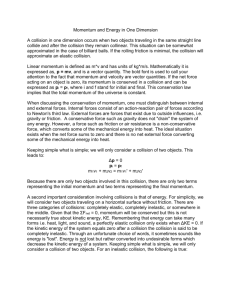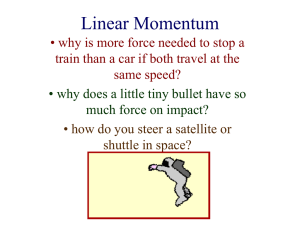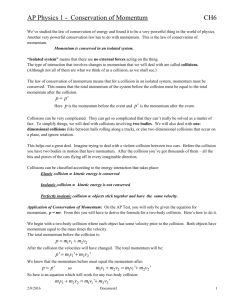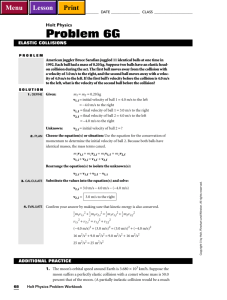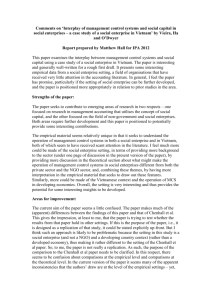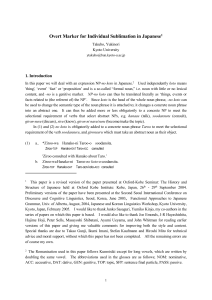doc
advertisement
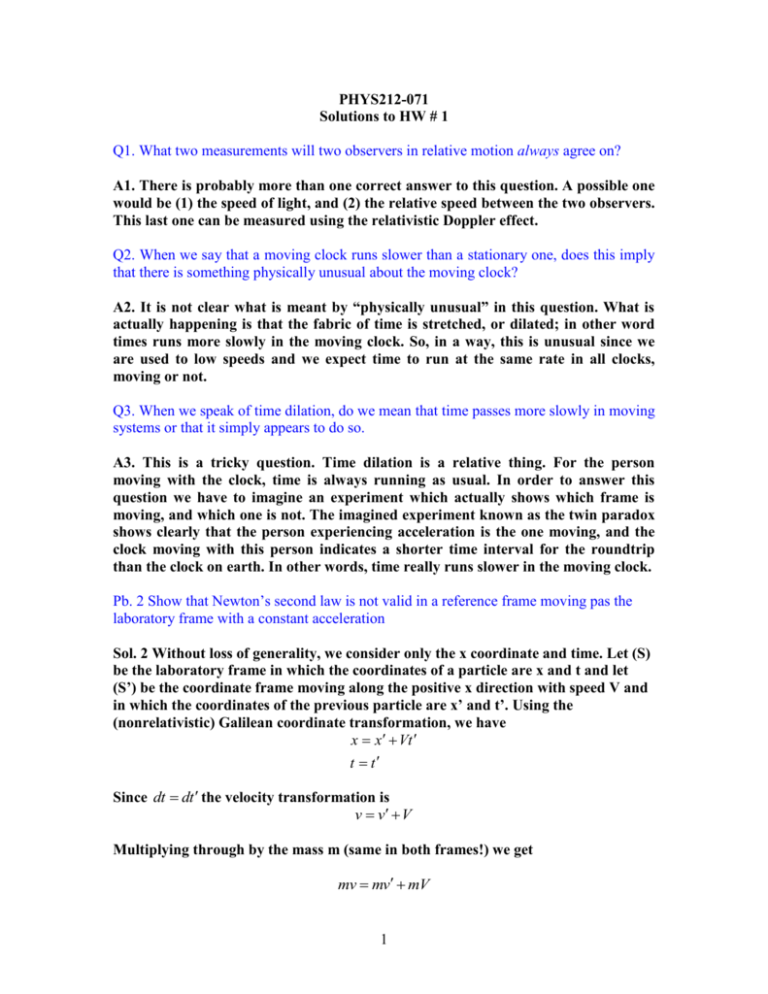
PHYS212-071 Solutions to HW # 1 Q1. What two measurements will two observers in relative motion always agree on? A1. There is probably more than one correct answer to this question. A possible one would be (1) the speed of light, and (2) the relative speed between the two observers. This last one can be measured using the relativistic Doppler effect. Q2. When we say that a moving clock runs slower than a stationary one, does this imply that there is something physically unusual about the moving clock? A2. It is not clear what is meant by “physically unusual” in this question. What is actually happening is that the fabric of time is stretched, or dilated; in other word times runs more slowly in the moving clock. So, in a way, this is unusual since we are used to low speeds and we expect time to run at the same rate in all clocks, moving or not. Q3. When we speak of time dilation, do we mean that time passes more slowly in moving systems or that it simply appears to do so. A3. This is a tricky question. Time dilation is a relative thing. For the person moving with the clock, time is always running as usual. In order to answer this question we have to imagine an experiment which actually shows which frame is moving, and which one is not. The imagined experiment known as the twin paradox shows clearly that the person experiencing acceleration is the one moving, and the clock moving with this person indicates a shorter time interval for the roundtrip than the clock on earth. In other words, time really runs slower in the moving clock. Pb. 2 Show that Newton’s second law is not valid in a reference frame moving pas the laboratory frame with a constant acceleration Sol. 2 Without loss of generality, we consider only the x coordinate and time. Let (S) be the laboratory frame in which the coordinates of a particle are x and t and let (S’) be the coordinate frame moving along the positive x direction with speed V and in which the coordinates of the previous particle are x’ and t’. Using the (nonrelativistic) Galilean coordinate transformation, we have x x Vt t t Since dt dt the velocity transformation is v v V Multiplying through by the mass m (same in both frames!) we get mv mv mV 1 Since the momentum of the particle is p mv in frame (S) and p mv in frame (S’), we have p p mV Assuming the mass m does not change with time, the time rate of change of the momentum of the particle as seen in the two frames will be dp dp dV dp m dt dt dt dt dp dV 0 , i.e. when Therefore, Newton’s second law F is not invariant when dt dt frame (S’) is not moving with a constant velocity with respect to frame (S). Pb. 4 A billiard ball of mass 0.3 kg moves with a speed of 5 m/s and collides elastically with a ball of mass 0.2 kg moving in the opposite direction with a speed of 3 m/s. Show that because momentum is conserved in the rest frame, it is also conserved in a frame of reference moving with a speed of 2 m/s in the direction of the second ball. Sol. 4 Let m1 = 0.3 kg and m2 = 0.2 kg be the masses of billiard balls 1 and 2, respectively. Let also v1 = + 5 m/s and v2 = - 3 m/s be the velocities of the balls in the laboratory frame (S) before the collision. The momenta of the balls in (S) before the collision are p1 = m1v1 = 0.3 kg x (+ 5 m/s) = 1.5 kg m/s p2 = m2v2 = 0.2 kg x (- 3m/s) = - 0.6 kg m/s The total initial momentum of the system (ball 1 + ball 2) is pi = p1 + p2 = 0.9 kg m/s The kinetic energies of the balls in (S) before the collision are K1 = ½ m1v12 = ½ x 0.3 kg x (+ 5 m/s)2 = 3.75 J K2 = ½ m2v22 = ½ x 0.2 kg x (- 3 m/s)2 = 0.9 J The total initial kinetic energy of the system (ball 1 + ball 2) is Ki = K1 + K2 = 4.65 J Let v1* and v2* be the velocities of the two balls after the collision as seen in frame (S). Since the collision is elastic, both the total momentum and total kinetic energy of the system (ball 1 + ball 2) are conserved. Therefore: m1v1* + m2v2* = 0.9 kg m/s ½ m1v1*2 + ½ m2v2*2 = 4.65 J Solving this system of equations for v1* and v2* we get a set of two possible solutions in frame (S): (A): v1* = + 5 m/s and v2* = - 3 m/s. This set corresponds to no scattering at all; the two balls just continue moving without touching each other. We do not consider this unphysical case. 2 (B): v1* = - 1.4 m/s and v2* = 6.6 m/s. This is the interesting case where we do have scattering. The balls elastically scatter off each other and reverse directions. This is the solution we will consider. Notice that the total momentum pf after the collision is pf = p1*+ p2* = m1v1*+ m2v2* = 0.3 kg x (-1.4 m/s) + 0.2 kg x (+ 6.6 m/s) = 0.9 kg = pi This is what we expect since we know that the total momentum is conserved in (S). Let us now analyze the momenta of the two balls in the moving reference frame (S’) moving with a velocity of – 2 m/s with respect to (S). Using the law of addition of velocities for Galilean transformations we have for the velocities of the two balls before the collision: v1’ = v1-V = 5 m/s – (- 2 m/s) = + 7 m/s v2’ = v2 –V = - 3 m/s – (- 2 m/s) = -1 m/s The total momentum of the two balls before the collision as measured in frame (S’) is: pi’ = m1v1’+m2v2’= 0.3 kg x (+7m/s) + 0.2 kg x (- 1 m/s) = 1.9 kg m/s Applying the law of addition of velocities to the velocities of the two balls after the collision we get v1*’ = v1* - V = - 1.4 m/s – (- 2 m/s) = + 0.6 m/s v2*’ = v2* - V = + 6.6 m/s – (- 2 m/s) = + 8.6 m/s The total momentum of the two balls after the collision as measured in frame (S’) is pf’ = m1v1*’ + m2v2*’ = 0.3 kg x (+ 0.6 m/s) + 0.2 kg x (+ 8.6 m/s) = 1.9 kg m/s = pi’ Therefore the total momentum is conserved in frame (S’). There is of course a general way of showing that if momentum is conserved in one inertial reference frame it must conserved in any other inertial reference frame moving with respect the first one with a constant velocity V. To see this, let us write the law of conservation of momentum in the frame (S): m1v1 + m2v2 = m1v1* + m2v2*, where the masses and velocities are defines as before. Applying the law of addition of velocities we get: m1(v1’+V) + m2(v2’+V) = m1(v1*’+V) + m2(v2*’+V) Therefore, m1v1’ + m2v2’ + (m1+m2)V = m1v1*’ + m2v2*’ + (m1+m2)V Which reduces to m1v1’+m2v2’ = m1v1*’ + m2v2*’. This means that momentum is also conserved in frame (S’) if it is conserved in frame (S), where (S’) is moving with a constant velocity V with respect to (S). Pb. 6 With what speed will a clock have to be moving in order to run at a rate that is one half the rate of a clock at rest? 3 Sol. 6. Let t 0 be the rate at which the clock is running in its rest frame and t the rate at which it is running in a frame in which it is seen moving with speed v . We have from time dilation t 0 t t 0 2 v 1 c t v 1 t t v Since t 0 , we have 0 1 1 0 1 2 c 4 c t t 2 2 2 4 3 0.866 4

